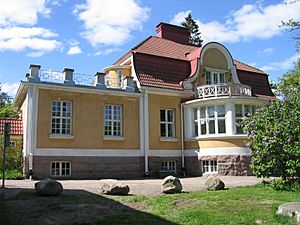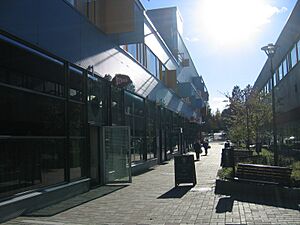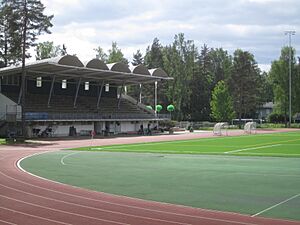Kauniainen facts for kids
Quick facts for kids
Kauniainen
|
||
|---|---|---|
|
Town
|
||
| Kauniaisten kaupunki Grankulla stad |
||

Villa Junghans in Kauniainen
|
||
|
||

Location of Kauniainen in Finland
|
||
| Country | ||
| Region | ||
| Sub-region | Helsinki sub-region | |
| Metropolitan area | Helsinki metropolitan area | |
| Charter | 1920 | |
| City rights | 1972 | |
| Area
(2018-01-01)
|
||
| • Total | 6.00 km2 (2.32 sq mi) | |
| • Land | 5.89 km2 (2.27 sq mi) | |
| • Water | 0.12 km2 (0.05 sq mi) | |
| Area rank | 313th largest in Finland | |
| Population
(2023-12-31)
|
||
| • Total | 10,270 | |
| • Rank | 95th largest in Finland | |
| • Density | 1,743.63/km2 (4,516.0/sq mi) | |
| Population by native language | ||
| • Finnish | 58.7% (official) | |
| • Swedish | 30.4% (official) | |
| • Others | 10.8% | |
| Population by age | ||
| • 0 to 14 | 17.9% | |
| • 15 to 64 | 60.4% | |
| • 65 or older | 21.7% | |
| Time zone | UTC+02:00 (EET) | |
| • Summer (DST) | UTC+03:00 (EEST) | |
| Climate | Dfb | |
| Website | www.kauniainen.fi | |
Kauniainen (pronounced KOW-nee-eye-nen) is a small town in Finland. It's located in the southern part of the country, surrounded by the city of Espoo. Kauniainen is part of the Helsinki Metropolitan Area, which is home to about 1.58 million people.
The town was started in 1906 by a company called AB Grankulla. They sold land for people to build country houses, called villas. Kauniainen became a market town in 1920 and officially a city in 1972.
Kauniainen has the lowest local tax rate in Finland ( %). This makes it an attractive place for families with higher incomes. Because of this, the town can offer good services to its residents while keeping taxes low.
Kauniainen is a bilingual municipality. This means both Finnish and Swedish are its official languages. About 59% of the people speak Finnish, 30% speak Swedish, and 11% speak other languages.
Contents
Understanding Kauniainen's Names
The Swedish name for the town is Grankulla. This name comes from two Swedish words: "gran" meaning spruce and "kulle" meaning hill. So, it means "Spruce Hill." This name has been used since the early 1900s. Before that, it was known by an older dialect name, Gränkull. You can still find Gränkull on maps today as the name of the hill where Kauniainen's water tower stands.
The Finnish name, Kauniainen, comes from a homestead (a small farm or estate) in the area called Kauniais. This homestead was named after another estate near Tampere. The Finnish name started being used in the 1930s. It became an official name for the town, along with the Swedish name, in 1949.
Kauniainen's Coat of Arms
The coat of arms for Kauniainen shows a golden red squirrel sitting on a blue background. The squirrel is holding a black spruce cone. Above the squirrel, there are three golden roses.
- The squirrel holding the spruce cone is a clever way to refer to the town's Swedish name, Grankulla (Spruce Hill).
- The three roses represent the many villas, or country houses, that were built in the area.
Ahto Numminen designed this coat of arms. It was officially approved in 1952.
A Brief History of Kauniainen
Early Beginnings
About 10,000 years ago, after the last Ice Age, the area that is now Kauniainen was just a few small islands in a sea called the Yoldia Sea. These islands are now the highest points in the town. As the land slowly rose, Kauniainen became part of an inner group of islands about 4,000 years ago. We know people lived here back then because pieces of pottery have been found. However, the first permanent homes were built much later, in the 1800s. Today, Kauniainen is several kilometers away from the sea.
In the early 1900s, Kauniainen was just a few small farms on the edge of larger farms in Espoo. The main road between Helsinki and Turku had passed through the northern part of Kauniainen for centuries. But a new railway line, opened in 1903, was very important for the area's growth.
The Villa Era
The modern history of Kauniainen began in 1906. A company called AB Grankulla bought land here. They then sold it to people who wanted to build villas outside of busy Helsinki. Other similar communities were started around Helsinki at the same time. The company's owners were happy with their investment, making their money back in just one year! The idea of building villas had actually started a few years earlier. Elia Heikel and Emil Lindstedt bought land around Gallträsk lake and built the first villas. All the properties sold were quite large, at least 3,000 square meters.
The larger municipality of Espoo didn't pay much attention to this new community. So, AB Grankulla took charge of developing it. They built roads, started a school, arranged for electricity, and pushed for a railway station (which opened in 1908) and a police office. In 1915, Kauniainen gained some independence from Espoo, and the company's role became less important.
Becoming a Market Town and City
In 1917, Kauniainen had 1,647 residents. In 1920, it became a market town, gaining full control over its own local government. Kauniainen was different from the rural areas around it in Espoo. It had a town plan, a road network, villas, and electricity. The goal was to keep Kauniainen a green, peaceful, rural community. Industrial buildings were not allowed. Most of the villas were built in a classical style or the newer functionalist style of the late 1920s.
Plans for a new town layout began in the late 1920s. However, people argued about the proposals, especially that the roads were too wide. The architect also passed away during the process. This meant a compromise wasn't reached until 1937. The population didn't grow much between 1917 and 1939, only about 10%. But the areas right outside the market town grew a lot.
Kauniainen has been officially bilingual since 1936. The Finnish name Kauniainen became official alongside the Swedish name Grankulla in 1949. Even before that, the Finnish name was used by the railways and postal service in the 1930s. The era of building many villas ended with World War II. After the war, times were challenging, and the focus was on rebuilding.
Kauniainen's independence as a municipality was sometimes at risk because it was small and had few residents. In the 1950s, the market town tried to add some surrounding areas from Espoo, but this was not approved. Instead, the area of Kasavuori, which the market town had bought, was added in 1957.
A new town plan was made by Otto-Iivari Meurman. He suggested keeping the villa style but greatly increasing the number of residents, from 2,500 to 10,000. He also suggested replacing older villas with new ones and building apartment buildings. A new shopping center was planned near the railway station. The plans for Kasavuori were approved in 1959, and for the rest of the town in 1961 and 1963. The shopping center opened in 1966. Some people later criticized this plan because many beautiful villas were torn down, changing the unique villa environment. A large skiing centre was planned in Kasavuori, but it was never built. Today, this area is protected.
The number of residents grew quickly. In 1967, it grew by as much as 25%! In 1972, Kauniainen officially became a city (in Finnish, kaupunki). The next year, Finnish speakers became the majority, and Swedish speakers the minority. At that time, the town had 6,400 residents. The commercial center has been seen as old-fashioned for over 20 years. A new plan for the town center was approved in 2006, and construction began that December.
The town's population passed 10,000 residents in 2020. At the end of 2020, there were 10,177 people living in Kauniainen.
Getting Around Kauniainen
Road Connections
Kauniainen has good road connections. The main motorway between Helsinki and Turku (national road 1) passes south of Kauniainen. The older main road (regional road 110) goes through the northern parts of town. When the motorway was built in the 1960s, it helped many new people move to Kauniainen. They could drive quickly to Helsinki's city center. The Kehä II (Ring Road 2), which runs north to south, passes the eastern edge of Kauniainen.
Public Transportation
Kauniainen has two commuter train stations: Kauniainen and Koivuhovi. These are on the Rantarata line, which opened in 1903. The railway has been very important for Kauniainen's growth as a suburb of Helsinki. Trains leave about every 15 minutes, and the ride to Helsinki Central railway station takes about 20 minutes.
There are also two regional bus lines that connect Kauniainen to Helsinki. Local bus lines connect to different areas of Espoo.
Services for Residents
Kauniainen offers many services for its residents, especially considering its small size. There are six schools in Kauniainen, covering different age groups and both Finnish and Swedish languages.
Here are some of the services and facilities in Kauniainen:
- swimming baths (swimming pools)
- Indoor ice rink
- Downhill skiing slope (the oldest in Finland, opened in 1934)
- Small athletics stadium
- Indoor sports arena (for sports like team handball and tennis)
- music school (for children)
- art school (for children)
- Public library
- adult education school
- health station
- Kauniaisten Jäähalli (ice hockey arena)
Town Districts
Kauniainen is divided into three main areas called I, II, and III. These areas don't have specific names because the town is quite small. The only area that is often called by a name is Kasavuori (in Swedish, Kasaberget), which is in the western part of the town.
Sports in Kauniainen
Kauniainen has many sports facilities, and the town council actively supports sports. There are activities for most sports, with Grankulla IFK (GrIFK) being the largest sports club. GrIFK was founded in 1925. Today, it has teams and activities in ice hockey, football, team handball, floorball, and alpine skiing.
Famous People from Kauniainen
- Isac Elliot, singer
- Marcus Grönholm, World Rally Championship racer
- Niclas Grönholm, racing driver and son of Marcus Grönholm
- Pia Julin, sports shooter
- Yrjö Kukkapuro, architect
- Petter Meyer, footballer
- Alexandra Olsson, handball player
- Jarmo Saari, guitarist, composer and record producer
- Toni Söderholm, ice hockey player
- Pasi Sormunen, ice hockey player
- Emelie Sederholm, singer-songwriter
- Monty Widenius, creator of MySQL and MariaDB
See also
 In Spanish: Kauniainen para niños
In Spanish: Kauniainen para niños







